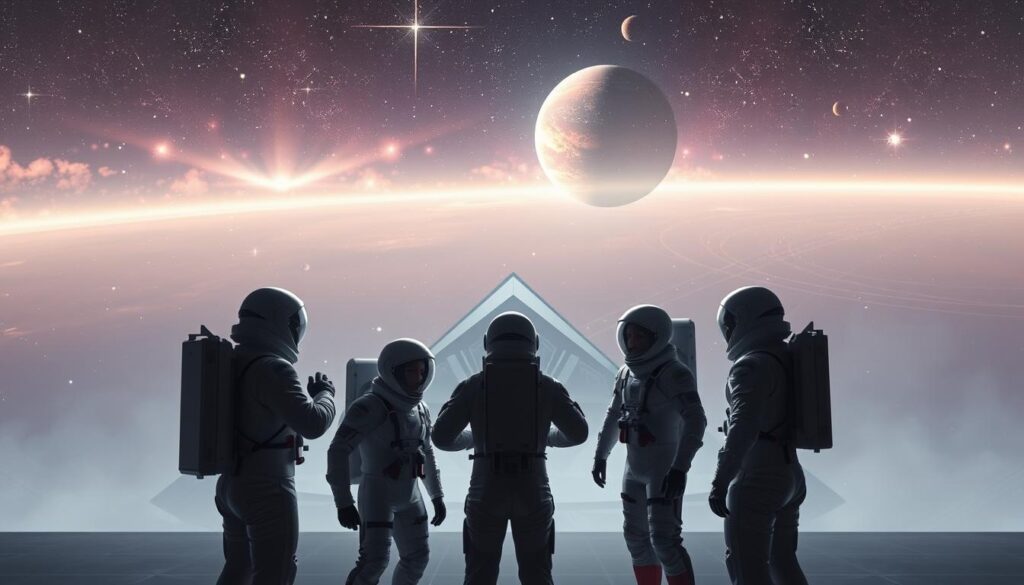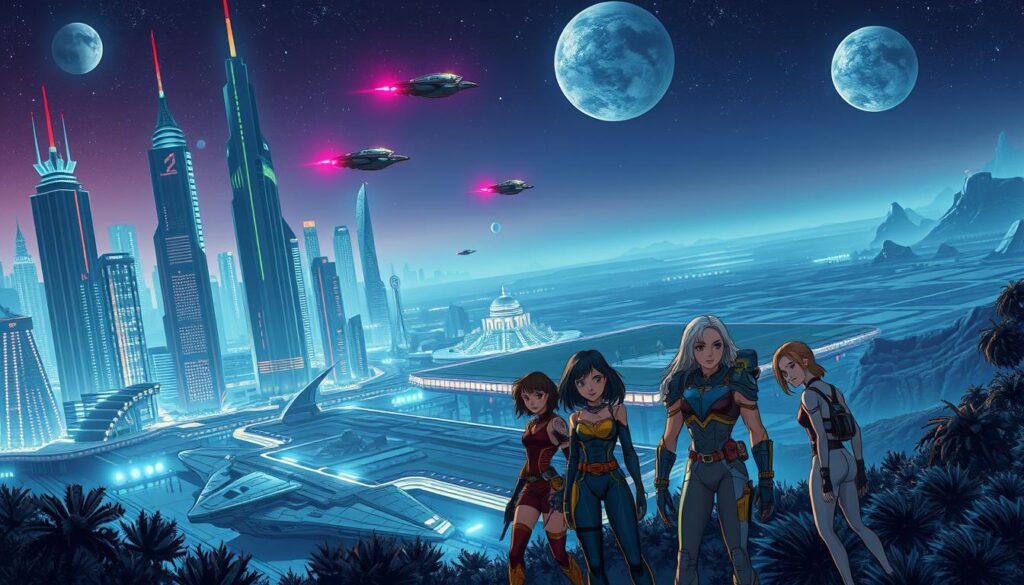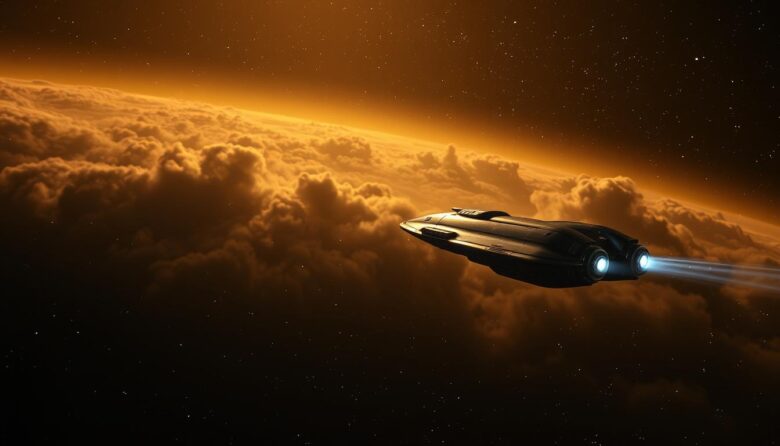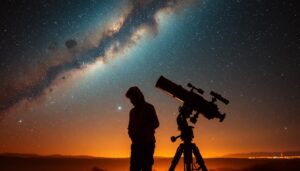Space has always fascinated humans. Sci-fi stories bring galaxies and alien worlds to life, sparking our imagination. They mix imagination with scientific curiosity, inviting us to dream big.
Since ancient times, humans have looked up at the stars with wonder. Sci-fi turns these questions into adventures. Movies like Star Wars and books like Dune shape our view of the cosmos.
These tales ask: What lies beyond Earth? How will we evolve in the stars? Sci-fi isn’t just entertainment—it’s a way to explore real possibilities.
It fuels our curiosity about planets, AI, and humanity’s future. This article explores how these stories mirror our real-world ambitions. It blends fiction and science to inspire us.
Key Takeaways
- Sci-fi stories highlight humanity’s endless curiosity about space.
- Classic films and books turn scientific ideas into relatable adventures.
- These narratives connect past dreams with today’s space tech advancements.
- Stories about space exploration often reflect current societal hopes and fears.
- Sci-fi’s blend of wonder and logic keeps the allure of space exploration alive.
The Fascination with the Cosmos in Sci-Fi
Humans have always looked up at the stars, curious about what’s out there. Science fiction connects our dreams with the real world, showing us what’s possible. From old tales to today’s movies, these stories make us think and dream big.
The Historical Context of Space Exploration
Books like Jules Verne’s From the Earth to the Moon (1865) and H.G. Wells’ The War of the Worlds (1898) started space stories. By the 1950s, Ray Bradbury in The Martian Chronicles talked about space travel and survival. These stories matched real events, like Sputnik’s launch in 1957, blending fiction with fact.
Notable Sci-Fi Works that Sparked Interest
- Arthur C. Clarke’s 2001: A Space Odyssey (1968) changed how we see stories and tech.
- Gene Roddenberry’s Star Trek (1966) showed us a future of hope and discovery.
- Andy Weir’s The Martian (2011) mixed science with adventure, showing us the beauty of space.
How Sci-Fi Shapes Public Perception
“Imagination will often carry us to worlds that never were… yet show us who we are.”
Sci-fi does more than entertain; it inspires us. NASA missions get support because of movies like Interstellar. By mixing magic with reality, space exploration in science fiction keeps our eyes on the stars.
Iconic Sci-Fi Space Missions in Literature and Film
Iconic Sci-Fi Space Missions in Literature and Film have shaped how we see the future of space travel. These stories mix imagination with science, making a big impact on pop culture and real-world innovation.
2001: A Space Odyssey and Its Impact
Kubrick’s 1968 masterpiece set new standards for futuristic space travel. It showed us realistic spacecraft and AI. Scenes like HAL 9000’s chilling dialogue are still remembered today.
It has influenced NASA’s concept art and inspired aerospace engineers. It also explored how humans and machines interact.
Interstellar: A Journey Through Time and Space
Christopher Nolan’s 2014 film mixed Einstein’s theories with emotional stories. The quote below shows its main theme:
“Love transcends time and space—it’s the one thing we’re capable of perceiving that can change the future.”
Working with physicist Kip Thorne made black holes and wormholes look real. This mix of science and drama is unique.
The Role of The Martian in Popularizing Mars Exploration
Ridley Scott’s adaptation of Andy Weir’s novel made futuristic space travel exciting. Mark Watney’s cleverness showed us:
- How to solve problems in extreme conditions
- Increased interest in NASA’s Mars rover missions
The film’s focus on teamwork and resourcefulness made Mars missions seem possible. It inspired both scientists and casual viewers.
The Role of Technology in Space Exploration
Sci-fi stories have long imagined otherworldly adventures powered by mind-bending tech. These visions often become blueprints for real-world innovation, blurring the line between fantasy and science.
Real vs. Fiction: Technologies Predicted in Sci-Fi
- Star Trek’s communicators inspired early cellphones.
- Holograms in Star Wars now aid medical training and engineering.
- HAL 9000’s AI in 2001: A Space Odyssey mirrors today’s autonomous Mars rovers.
How Sci-Fi Influences Real Technological Advancements
Modern breakthroughs often trace roots to fictional ideas:
- SpaceX’s Starship echoes spacecraft designs from Star Trek.
- Drone tech in Minority Report inspired Mars rover navigation systems.
- Exoskeletons from Iron Man now assist astronauts in training simulations.
These stories don’t just entertain—they challenge engineers to turn dreams into tools. As otherworldly adventures fuel creativity, tomorrow’s tech may soon rival the boldest sci-fi concepts.
The Cultural Impact of Space Exploration in Sci-Fi
Space exploration novels reflect our society’s values. They show us alien encounters and diverse crews. These stories challenge our norms and spark curiosity about our place in the universe.
Alien Civilizations
Alien societies in these novels often represent cultural clashes or unity. Ursula K. Le Guin’s The Left Hand of Darkness questions human gender roles with androgynous aliens. Arrival shows the importance of language diversity through alien communication.
Gender and Diversity
Today’s space exploration novels feature diverse protagonists. N.K. Jemisin’s The Broken Earth Trilogy introduces Black heroes, changing our view of heroism. Octavia Butler’s Parable of the Sower explores leadership through marginalized voices.
| Cultural Perspective | Key Themes | Example |
|---|---|---|
| Western | Colonization, innovation | Kim Stanley Robinson’s Mars Trilogy |
| Japanese | Harmony with technology | Stories from Planetes |
| African | Ancestral connections | Nnedi Okorafor’s Binti series |
These stories show that space exploration novels are more than just fun reads. They help us question our biases and celebrate our shared curiosity.
Emotional Appeal: The Human Connection to Space
Starting an outer space odyssey touches our hearts more than any star. Sci-fi tales show us that space travel is about more than just technology. They share stories of fear and dreams, making them relatable to us all.
Themes of Loneliness and Isolation
Astronauts in films and books often face endless silence. The outer space odyssey of loneliness is both physical and mental. Imagine being alone, millions of miles from home.
Stories like these echo the real feelings of astronauts. Carl Sagan once said, “We’re like the starfish on the ocean floor, but we’re on a cosmic shore.”
The Quest for Knowledge and Adventure
Curiosity pushes humans to explore. Sci-fi heroes seek answers, not just stars. The excitement of discovery, like finding water on Mars, drives both fiction and real missions.
This quest turns astronauts into pioneers. They mix bravery with wonder. Their journeys make us wonder, “What’s next?”
These tales make space a mirror of our desires to belong and grow. Every star reminds us that our biggest adventure is our shared curiosity.
Ethical Dilemmas in Space Exploration Narratives
Sci-fi movies often make us think about right and wrong in space. They deal with first contact with aliens and using distant planets. These stories make us ponder the choices we might make in the future.

The Moral Implications of Alien Encounters
What if humans meet intelligent life? Films like Arrival and Contact show the tough choices we face. Should we share our tech? How do we respect their rights? These movies turn these questions into urgent moral tests.
Environmental Concerns in Galactic Ventures
These movies also warn against greed. In Avatar, greed harms alien worlds, like Earth’s environmental issues. Scenes of mining moons or changing planets ask: Can we explore without harming? These stories reflect today’s debates on asteroid mining and protecting planets.
“Every step we take leaves a footprint.” — Ad Astra
Sci-fi movies make us think about alien rights and saving planets. They show that space travel is not just about discovery. It’s about being responsible.
The Future of Space Exploration in Sci-Fi
Galactic exploration themes are always changing, mixing dreams with science. Sci-fi shows us a future where humans go beyond Earth, thanks to new ideas and curiosity.
Speculative Technologies and Concepts
- Quantum drives enabling faster-than-light travel
- AI companions guiding deep-space missions
- Self-sustaining colonies on distant moons
Predictions for Humanity’s Role in Space
Sci-fi sees humans as pioneers in space. Mars colonies and interstellar diplomacy are key themes. With SpaceX heading to Mars, stories now talk about living with alien life.
“The next century could turn sci-fi visions into reality—bases on the moon, mining asteroids, and first contact missions,” said Dr. Elena Torres, astrobiologist at NASA.
Stories talk about holographic maps and farms in space. They show us what’s possible, like NASA’s Artemis program. It connects fiction with reality.
| Sci-Fi Concept | Real-World Progress |
|---|---|
| AI pilots | Autonomous spacecraft prototypes |
| Moon bases | Blue Origin’s lunar habitat plans |
Galactic exploration themes tell us that tomorrow’s discoveries start as today’s dreams. The stars are calling, not just as a challenge, but as a shared journey.
How Sci-Fi Inspires Real-World Space Programs
Imagining the future isn’t just for storytellers. Sci-fi ideas now fuel real missions. They turn dreams into rockets and rovers.
“Science fiction is the training wheels of reality.” – Former NASA engineer, Robert Lightfoot
NASA and Its Influence from Sci-Fi
NASA’s journey mirrors fictional milestones:
- 2001: A Space Odyssey inspired the design of the International Space Station
- Robotic explorers like Perseverance Mars rover mirror scenes from The Martian
- Artemis moon missions draw visuals from retro-futuristic lunar bases seen in 1960s sci-fi films
Private Companies: Merging Fiction with Reality
Startups are rewriting the script:
- SpaceX’s Starship echoes Star Trek’s USS Enterprise with its sleek, reusable design
- Blue Origin’s lunar lander concepts borrow aesthetics from Alien’s orbital habitats
- Virgin Galactic’s suborbital flights resemble Star Wars’ joyrides to space stations
From Hollywood sets to launchpads, sci-fi isn’t just entertainment. It’s a blueprint for tomorrow’s breakthroughs.
The Role of Graphic Novels and Comic Books
Graphic novels and comic books bring cosmic dreams to life. They combine art and text in a unique way. This makes space exploration more vivid and real.

Pioneering Sci-Fi Illustrators and Their Legacy
Legendary artists have shaped our view of space. Jack Kirby’s bold designs for Marvel’s cosmic sagas inspired many. Alex Ross brought photorealism to DC’s Kingdom Come. Meanwhile, Moebius’s dreamlike worlds in The Incal redefined alien landscapes.
Their work didn’t just tell stories—it set trends. They changed how we see space.
The Visual Storytelling of Space Exploration
Comic art turns abstract ideas into images. It shows how stories differ in prose versus visual formats:
| Concept | Literature Description | Comic Book Visuals |
|---|---|---|
| Spaceships | Described with engine specs | Showcased with glowing thrusters and sleek hulls |
| Alien Worlds | Described through metaphors | Depicted with neon-colored flora and geometric structures |
| Futuristic Tech | Explained through dialogue | Showcased via intricate machinery and holographic interfaces |
These visuals let readers experience space through sight, not just words. Their impact is seen in today’s sci-fi media. It shows that art and narrative are closely linked.
Conclusion: The Everlasting Allure of the Unknown
Sci-fi stories about stars and distant worlds have always sparked our curiosity. From the first rocket ship dreams to today’s Mars rovers, stories guide our view of space. They show us that every achievement, from satellites to SpaceX, started as a dream.
Reflection on the Journey Through Space in Sci-Fi
Stories like Interstellar and 2001: A Space Odyssey reflect real space challenges. They ask us: What lies beyond our planet? How do we balance risk and discovery? These questions motivate filmmakers and NASA engineers.
These stories also spark debates on ethics and sustainability. They show sci-fi’s power to challenge our thinking.
Encouraging Future Explorations and Narratives
As companies like Blue Origin explore new frontiers, new stories must follow. Diverse voices and tales will drive tomorrow’s innovations. Sharing these stories sparks wonder in all ages.
The next generation’s missions to Europa or Mars will need creativity. Just like The Martian did. Keep imagining. The cosmos still holds secrets and stories waiting to be found.



